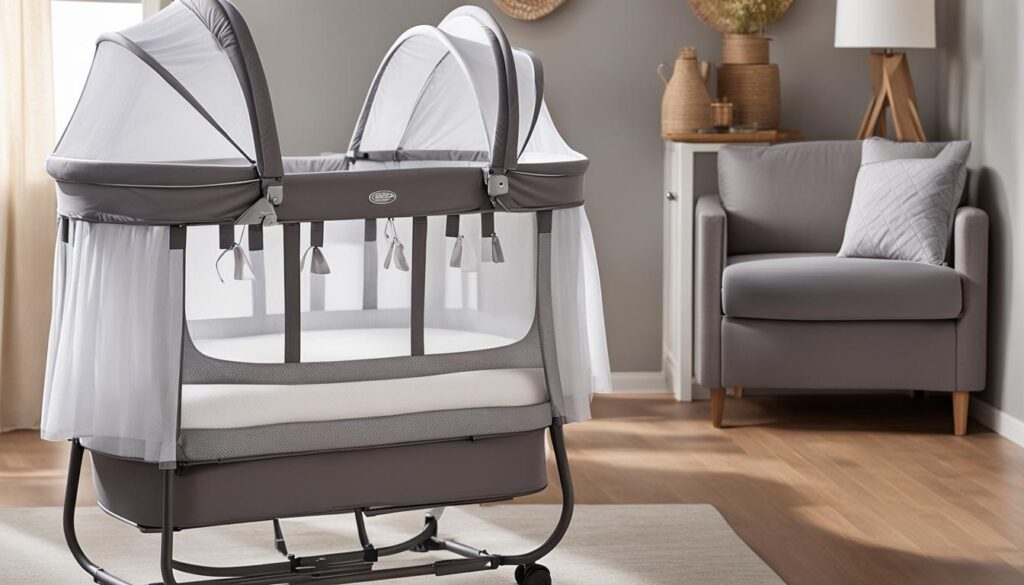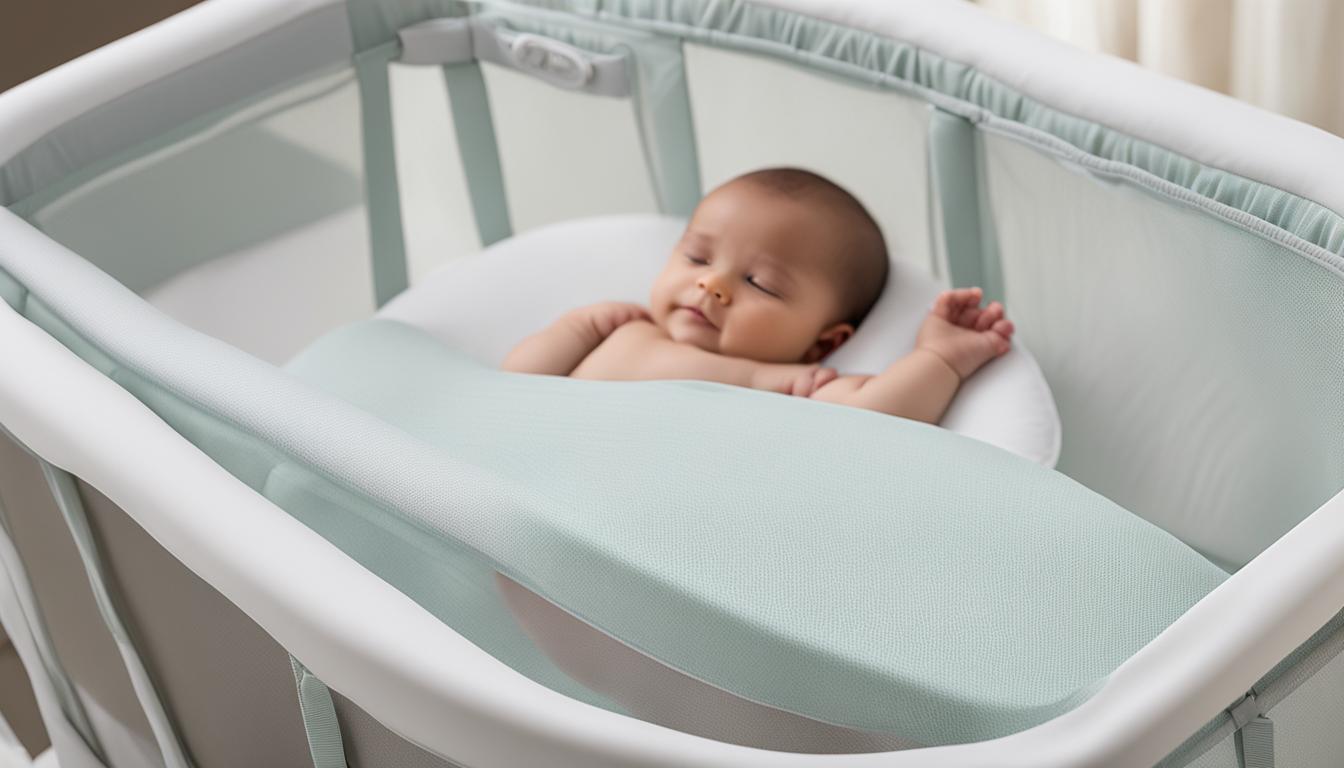Explore Different Types of Bassinets for Your Baby
Bringing home a newborn baby is an exciting and special time for parents. Ensuring your baby has a safe and comfortable sleeping space is a top priority. Bassinets are a popular choice for many parents because of their compact size and convenience.
Bassinets are smaller than cribs, allowing them to be placed right next to your bed, providing easy access to your baby during the night. They also offer the flexibility to be moved from room to room, keeping your baby close by wherever you are in the house.
It’s important to note that bassinets have weight and height limits. Babies should be transitioned to a crib once they outgrow the bassinet or start showing signs of pushing up onto their hands and knees. All bassinets sold in the U.S. must comply with federal safety regulations, ensuring that they are sturdy and free of harmful chemicals.
Key Takeaways:
- Different Types of Bassinets provide a safe and comfortable sleeping space for your baby.
- Bassinets are smaller than cribs and can be moved easily from room to room.
- Make sure to transition your baby to a crib once they outgrow the bassinet or show signs of pushing up.
- All bassinets sold in the U.S. comply with federal safety regulations to ensure their quality and safety standards.
- Choosing the right bassinet for your baby’s needs is important for their comfort and safety.
The Benefits of Using a Bassinet for Your Newborn
Using a bassinet for your newborn offers several benefits. It allows you to keep your baby close to you during the night, making it easier for feeding and comforting. Bassinets are compact and lightweight, making them ideal for small spaces and travel. They also provide a secure and breathable sleeping environment for your baby, with mesh walls for better air circulation.
When using a bassinet, it’s important to follow safety guidelines, such as using a firm mattress, keeping the bassinet free of toys and blankets, and ensuring the bassinet is stable and secure.
One of the key features of a bassinet is its compact and portable design. This allows parents to easily move it throughout the house or take it with them when traveling. The lightweight nature ensures that you can always keep your baby within arm’s reach, providing a sense of security and convenience.
Additionally, bassinets often come with features that enhance the safety and comfort of your baby. The breathable mesh walls promote better airflow, reducing the risk of overheating during sleep. The firm mattress provides a supportive surface for your baby’s delicate body, reducing the risk of suffocation or improper alignment.
“Using a bassinet for my newborn was a game-changer. I loved being able to have my baby right next to me at night, making nighttime feedings so much easier. The mesh walls and firm mattress gave me peace of mind, knowing that my baby was in a safe and comfortable sleeping environment.” – Sarah, mother of two
By using a bassinet, you can create a cozy sleeping space for your baby while still keeping them close. Having your baby near you can make nighttime feedings and comforting more convenient, allowing you to quickly respond to their needs. It also promotes bonding and a sense of security for both you and your little one.
However, it’s important to ensure that you adhere to bassinet safety guidelines. Always use a firm mattress that fits snugly in the bassinet to prevent suffocation risks. Keep the bassinet free of toys, loose bedding, and blankets that can pose hazards to your baby. Additionally, check that the bassinet is stable and secure, with sturdy and lockable wheels if necessary.
By choosing a bassinet that combines practical features and adheres to safety guidelines, you can provide your newborn with a comfortable and secure sleeping environment.
Different Types of Bassinets to Consider
When it comes to choosing a bassinet for your baby, there are several different options available on the market. Each type of bassinet offers unique features and benefits, allowing you to find the perfect sleeping solution for your little one. In this section, we will explore the various types of bassinets, including portable bassinets, and provide a comparison to help you make an informed decision.
Traditional Bedside Bassinets
Traditional bedside bassinets are freestanding and larger in size compared to other types of bassinets. They offer additional storage space, such as storage baskets or shelves, making it convenient to keep essentials like diapers, wipes, and blankets within reach. Some traditional bassinets also come with rocking features, allowing you to gently soothe your baby to sleep. These bassinets are ideal for parents who prefer a more traditional design and need extra storage for baby essentials.
Bedside Sleepers
Bedside sleepers are designed to attach to the side of your bed, providing easy access to your baby during the night. These bassinets offer a safe sleeping space for your little one while keeping them close to you, enhancing bonding and making nighttime feeding easier. Bedside sleepers are adjustable in height, allowing them to match the height of your bed perfectly. This type of bassinet is ideal for parents who desire proximity to their baby at all times without sharing the same sleeping surface.
Travel Bassinets
Travel bassinets are lightweight and portable, making them perfect for parents who are constantly on the go or frequently moving around the house. These bassinets are designed with convenience in mind, easily foldable and compact enough to fit into a travel bag. They offer a safe and comfortable sleeping environment for your baby, ensuring they can sleep soundly whether at home or on the road. Travel bassinets are a popular choice for families who frequently travel or visit friends and family.
Smart Bassinets
Smart bassinets are equipped with advanced features and technology to enhance your baby’s sleep experience. These bassinets often come with automated rocking motions, built-in sound machines, and even monitoring capabilities, allowing you to keep an eye on your baby’s sleep patterns and well-being. Smart bassinets are designed for tech-savvy parents who want added convenience and features to assist in providing a safe and soothing sleep environment for their baby.
When choosing a bassinet for your baby, consider your specific needs and preferences. Think about factors such as portability, additional features, and design. Understanding the different types of bassinets available will help you make an informed decision that suits both you and your baby’s needs.
Features to Look for When Buying a Bassinet
When buying a bassinet, there are several features to consider that will ensure your baby’s comfort and convenience. These features include:
- A Firm Mattress and Tight-Fitting Sheet: Look for a bassinet with a firm mattress to provide optimal support for your baby’s developing spine. The mattress should fit snugly in the bassinet without any gaps. Additionally, ensure that the bassinet comes with a tight-fitting sheet to maintain a safe sleeping environment.
- Mesh Walls for Better Ventilation: Opt for a bassinet with mesh walls to promote airflow and prevent overheating. This feature allows for improved breathability, ensuring your baby stays comfortably cool while sleeping.
- Side Pockets for Storage: Consider a bassinet with side pockets to conveniently store essentials such as diapers, wipes, or pacifiers within easy reach.
- Adjustable Height: Look for a bassinet with an adjustable height feature that allows you to customize the height according to your bed. This ensures that you can easily reach and soothe your baby during nighttime feeds without having to strain or bend over.
- Lockable Wheels: Bassinets with lockable wheels offer enhanced mobility and stability. This feature allows you to easily move the bassinet from room to room or lock it in place when desired.
- Add-On Features: Some bassinets come with additional features like vibration settings, white noise, or musical melodies to help soothe your baby to sleep. These optional features can provide added comfort and relaxation for your little one.
It’s important to choose a bassinet that not only meets your baby’s needs but also complies with safety standards. Look for certifications from reputable organizations such as the Juvenile Products Manufacturers Association (JPMA) or the American Society for Testing and Materials (ASTM). These certifications assure that the bassinet has undergone rigorous testing and meets the necessary safety requirements.

Bassinet Comparison
Here is a comparison table showcasing different bassinet models that offer a range of features:
| Bassinet | Firm Mattress | Mesh Walls | Side Pockets | Adjustable Height | Lockable Wheels | Add-On Features |
|---|---|---|---|---|---|---|
| Model A | ✓ | ✓ | ✓ | ✓ | ✓ | Vibration, Music |
| Model B | ✓ | ✓ | ✓ | ✓ | ✓ | White Noise |
| Model C | ✓ | ✓ | ✓ | ✓ | ✓ | – |
| Model D | – | – | – | ✓ | ✓ | – |
Safety Standards and Guidelines for Bassinets
When purchasing a bassinet, it’s crucial to prioritize the safety of your baby. Following bassinet safety guidelines will help ensure a secure sleeping environment. Here are some key safety standards and guidelines to consider:
1. Proper Padding Thickness
The padding in a bassinet should not exceed 1.5 inches thick. This helps prevent suffocation risks and ensures that your baby can breathe comfortably while sleeping.
2. Sturdy Mesh Walls
The mesh walls of a bassinet should be sturdy enough to prevent the baby from getting stuck or trapped. This is especially important to ensure your baby’s safety during moments of movement.
3. Minimum Depth Requirement
The bassinet should have a minimum depth of 10 inches to keep your baby safe as they start to move. This depth ensures that they cannot roll out or accidentally fall over the side.
4. Stability of Legs and Wheels
Before purchasing a bassinet, check the stability of its legs and wheels. Ensure that they are strong and secure to prevent accidents or tipping over when your baby moves or when pressure is applied to the bassinet.
5. Certification by JPMA or ASTM
Look for bassinets that are certified by recognized organizations such as the Juvenile Products Manufacturers Association (JPMA) or the American Society for Testing and Materials (ASTM). Certification ensures that the bassinet meets stringent safety standards and guidelines.
By considering these safety standards and guidelines when purchasing a bassinet, you can provide your baby with a safe and secure sleeping space. Always prioritize safety to give you peace of mind as your baby sleeps soundly.

Tips for Choosing the Right Bassinet
When it comes to choosing a bassinet for your baby, there are a few important factors to consider. Firstly, think about the size of your room and whether you have enough space for a full-size bassinet or if a portable option would be more suitable. Additionally, consider your budget and how much you are willing to invest in a high-quality bassinet that meets all safety standards.
Reading reviews from other parents can provide valuable insights and help you make an informed decision. Their firsthand experiences can give you a better understanding of the pros and cons of different bassinets. Look for bassinets that have received positive reviews and recommendations from other users.
When browsing for a bassinet, check for certifications and safety labels. These indicate that the bassinet has undergone rigorous testing and meets all necessary safety standards. If you are considering using a hand-me-down bassinet, make sure to research whether it complies with current safety regulations and has not been subject to any recalls.
Finally, choose a bassinet that reflects your personal style and preferences. Whether you prefer a sleek and modern design or a more traditional look, there are plenty of options available to suit your aesthetic taste. Remember, your baby’s comfort and safety should always be the top priority when selecting a bassinet.
FAQ
What are the different types of bassinets available?
There are traditional bedside bassinets, bedside sleepers, travel bassinets, and smart bassinets.
What are the benefits of using a bassinet for a newborn?
Bassinets allow you to keep your baby close, provide a compact and breathable sleeping space, and offer flexibility for small spaces and travel.
What features should I look for when buying a bassinet?
Look for a bassinet with a firm mattress, mesh walls for ventilation, and additional features like side pockets and adjustable height.
What safety guidelines should I follow when using a bassinet?
Use a firm mattress, keep the bassinet free of toys and blankets, and ensure the bassinet is stable and secure.
How do I choose the right bassinet for my needs?
Consider factors like the size of your room, budget, and specific needs of your baby. Read reviews, check certifications, and choose a style you prefer.









